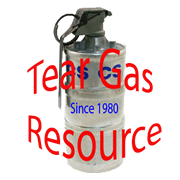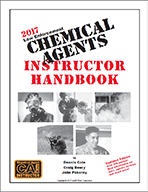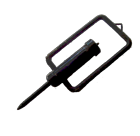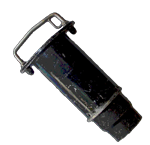PERSONAL - Personal decontamination generally refers to a person's skin and clothing. Tear gas is nothing more than a solid chemical or particle that becomes airborne and lands on a person's skin and is breathed into their respiratory system.
Decontamination procedures are based on this principal. Once we remove all the particles of chemical the physiological effects of the tear gas should cease. In most cases the psychological effects will cease with the physiological effects.
 The first step in personal decontamination is the same as immediate first aid for exposure to most tear gases. Remove the person or yourself to fresh air. If the wind is blowing, face the wind. In most cases the wind and a person's normal breathing action is enough to decontaminate the individual. Brisk movement can help: flapping the arms and rubbing the hair in a breeze or standing in front of a large fan. This will disperse most of the particles from the clothing and hair. Within five to ten minutes the symptoms produced by the agent should disappear. To help remove the chemical from the lachrymator glands (most commonly called tear ducts) eyes must be
The first step in personal decontamination is the same as immediate first aid for exposure to most tear gases. Remove the person or yourself to fresh air. If the wind is blowing, face the wind. In most cases the wind and a person's normal breathing action is enough to decontaminate the individual. Brisk movement can help: flapping the arms and rubbing the hair in a breeze or standing in front of a large fan. This will disperse most of the particles from the clothing and hair. Within five to ten minutes the symptoms produced by the agent should disappear. To help remove the chemical from the lachrymator glands (most commonly called tear ducts) eyes must be 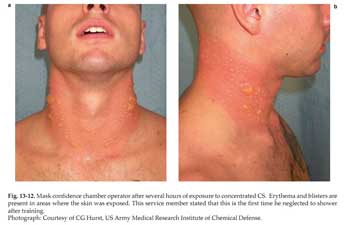 forced wide open. This should be done using eye muscles and not fingers. Rubbing irritated areas, especially the eyes, push the chemicals into the pores of the skin and intensify and prolong the irritation.
If the irritation persists or in a case of severe irritation, you can irrigate the eyes with large amounts of clean cool water.
forced wide open. This should be done using eye muscles and not fingers. Rubbing irritated areas, especially the eyes, push the chemicals into the pores of the skin and intensify and prolong the irritation.
If the irritation persists or in a case of severe irritation, you can irrigate the eyes with large amounts of clean cool water.
In the case of CN contamination a saline solution consisting of one-half teaspoon (2.5 cc) salt, to a quart (liter) of water can be used. In the case of CS contamination a solution of one per cent sodium bicarbonate and water can be used to flush the eyes. When using OC water and ice only should be used. Several commercial products like ChemWipes can be used to help flush OC off the skin.
Severely contaminated clothing should be removed as soon as practical. This clothing should not be mixed with other wash. The contaminated person may shower to remove any residual agent on his/her skin. During this process no oil based soap should be used. The oil in the soaps may trap chemical against the skin. 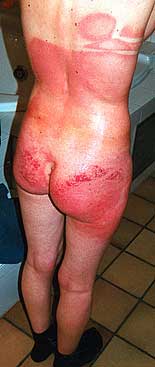 Theoretically this could cause skin burns. Much soap such as Borax, Ivory, Lava and tincture of green soap are available with no oils in them. No oils, creams or salves should be used in the personal decontamination process. These also will trap the chemical against the skin.
Theoretically this could cause skin burns. Much soap such as Borax, Ivory, Lava and tincture of green soap are available with no oils in them. No oils, creams or salves should be used in the personal decontamination process. These also will trap the chemical against the skin.
If the contaminated person's skin or scalp is tingling there is probably still agent present. A shower at this time may spread the agent to areas of the body that are still uncontaminated. Care should be taken to wash the body, especially the hair, in a manner that will not increase the spread of the agent.
When washing the clothing one should use detergent such as Tide or Joy. The chemicals in these soaps will help break down any of the chemical left in the clothing. Clothing should be left outside, exposed to natural air currents, overnight before being washed. This will eliminate most if not all of the residual agent. This will lessen the possibility that agent will be left in your washing machine. Clothes contaminated with CN can be placed in a dryer on high setting for twenty to thirty minutes. The heat produced by the dryer will help break down the CN. The dryer must be well ventilated to the outside so agent that becomes airborne will be vented to the outside.
The United States Navy's decontamination procedures for your gas mask are:
- Remove your filters Dip mask in one percent calcium hypochlorite solution for one to twenty-four hours
- Rinse in warm to hot water
- Dry in warm to hot, dry, fresh air current
- Look for agent residue
- If no residue replace filters
Several commercial products are on the market that claim they can be used as a decontaminating agent. These are both referred to as a tear gas neutralizing agent. Tests conducted have found that these gas neutralizing agents are very slow to counter the chemical effects. The active chemical in these neutralizers encapsulate the chemical crystals rendering the chemical inert or removing it from direct contact with the skin. The manufacturers advertise that the product can be applied directly to the human skin and mucous membranes safely.
There are also wipes, manufactured for the express purpose of serving to decontaminate someone having received a dose of pepper spray. Most of these products are very slow to work and decrease the effects at the most.
Water in limited quantities increases the pain symptoms from OC, which has a water solubility of 0.090 g/L at 37° C. Without decontamination, OC symptoms should dissipate over time as the body's substance P is diminished. OC resin can also be decontaminated with copious amounts of water, liquid soap and water, or baby shampoo. OC in the eyes can be decontaminated with copious water flushing, but symptoms may not dissipate for 10 minutes. OC or Capsaicin is not soluble in water, and even large volumes of water will not wash it off.
In general, victims are encouraged to blink vigorously in order to encourage tears, which will help flush the irritant from the eyes. A formal study of five often-recommended treatments for skin pain (Maalox, 2% lidocaine gel, baby shampoo, milk, or water) concluded that: "...there was no significant difference in pain relief provided by five different treatment regimens. Time after exposure appeared to be the best predictor for decrease in pain..."
Dilute Chlorine Bleach has been reportedly used with very good results in ER situations for external use only (non-occular application). A 1 part to 5 part water solution is recommended.
Using contact lens wetting solution seems to help occular relief. To avoid rubbing the spray into the skin, thereby prolonging the burning sensation, and, in order to not spread the compound to other parts of the body, victims should try to avoid touching affected areas. Many ambulance services and emergency departments use baby shampoo to remove the spray and with generally good effect.
Some of the OC and CS will remain in the respiratory system, but a recovery of vision and the coordination of the eyes can be expected within 7 to 15 minutes.
Some "triple-action" pepper sprays also contain CS, which reportedly can be neutralized with sodium metabisulfite (Campden tablets, used in home brewing), though it, too, is not water-soluble and must be washed off using the same procedure as for pepper spray.
